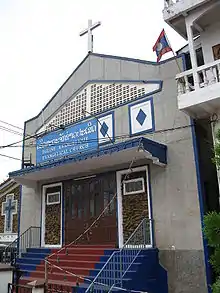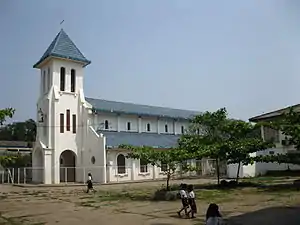Christianity in Laos
Christianity is a minority religion in Laos. Christians in Laos number 150,000, divided approximately equally between Protestant and Catholics.[1] There are three major Churches in Laos: the Lao Evangelical Church, the Seventh-day Adventist Church and the Roman Catholic Church. The Laotian government has enacted legislation aimed against Christians, and heavily monitors all Christian activities.[2]
| Christianity by country |
|---|
 |
|
|
Protestantism
Approximately 400 Protestant congregations conduct services throughout the country for a community that has grown rapidly in the past decade. Church officials estimate Protestants to number as many as 150,000.


Many Protestants are members of ethnic Mon-Khmer groups, especially the Khmu in the north and the Brou in the central provinces. Numbers of Protestants have also expanded rapidly in the Hmong and Yao communities. In urban areas, Protestantism has many lowland Lao followers. Most Protestants are concentrated in Vientiane Municipality, in the provinces of Vientiane, Sayaboury, Luang Prabang, Xieng Khouang, Bolikhamsai, Savannakhet, Champassak, and Attapeu, as well as in the former Saisomboun Special Zone, but smaller congregations are located throughout the country.
The LFNC officially recognizes only two Protestant groups – the LEC and the Seventh-day Adventist Church – and requires all non-Catholic Christian groups to operate under one of these organizations. Seventh-day Adventists number slightly more than 1,000 country-wide, with congregations in Vientiane Municipality as well as Bokeo, Bolikhamsai, Champassak, Luang Prabang, and Xieng Khouang provinces.
Christian denominations that have some following in the country, but which are not recognized by the government, include the Methodists, Church of Christ, Assemblies of God, Lutherans, Baptists, Jehovah’s Witnesses and The Church of Jesus Christ of Latter-day Saints. Official membership numbers are not available.
All approved Christian religious groups own properties in Vientiane Municipality, although some of their properties are not officially recognized by the Government. In addition, the Protestant LEC maintains properties in the cities of Savannakhet and Pakse. Three informal churches, one for English-speakers, one for Korean-speakers, and one for Chinese-speakers, serve Vientiane's foreign Protestant community.
In 2005, a Protestant church in Savannakhet Province was closed down by the government. Among the Hmong of Laos 20% were Christians in 1998. With around 300 congregations, Protestantism has grown rapidly in the last decade.[3] Members of the Seventh-day Adventist Church in Laos are mainly Chinese and Meos. At the end of June 30, 2019 it had four churches and 1,419 members.[4]
Religious freedom
According to the US government and other agencies there have been instances of the Laotian government attempting to make Christians renounce their faith, and have several times closed down Christian churches.[5] They also say that there are two religious prisoners in Laos, both members of the Lao Evangelical Church, and that in 2005, a church in Savannakhet Province was closed down by the government.[3] Lao officials have denied that they have closed any churches and say that Christians are imprisoned for other reasons.[2] In 2010 Amnesty International called for the government to allow freedom of speech.
Catholicism


The Roman Catholic Church is officially recognized by the LFNC.[6] Roman Catholicism first entered Laos when Laos was a French colony. There are approximately 45,000 Catholics, many of whom are ethnic Vietnamese, concentrated in major urban centers and surrounding areas along the Mekong River in the central and southern regions of the country.[6] The Catholic Church has an established presence in five of the most populous central and southern provinces, and Catholics are able to worship openly.[6] The Catholic Church's activities are more circumscribed in the north.[6] There are four bishops, two located in Vientiane and others located in the cities of Thakhek and Pakse.[6]
One of the two bishops resident in Vientiane oversees the Vientiane Diocese and is responsible for the central part of the country.[6] The second bishop resident in Vientiane is the Bishop of Luang Prabang.[6] He is assigned to the northern part of the country, but while the Government did not permit him to take up his post, it did permit him to travel to visit church congregations in the north.[6] The church's property in Luang Prabang was seized after 1975, and there is no longer a parsonage in that city.[6] An informal Catholic training center in Thakhek prepared a small number of priests to serve the Catholic community.[6] Several foreign nuns temporarily serve in the Vientiane diocese.[6]
There are no dioceses in the country, but it is divided into four Apostolic Vicariates: the Vicariate Apostolic of Luang Prabang, the Vicariate Apostolic of Paksé, the Vicariate Apostolic of Savannakhet, and the Vicariate Apostolic of Vientiane.[7]
References
- Laos: Evolution of the religious situation, Religioscope, 14 February 2003 (in French)
- "Christian Persecution in Laos". Open Doors USA. 2018.
- "Annual Report on International Religious Freedom". US State Department. September 2004. Archived from the original on 23 June 2006. Retrieved 2006-07-22.
- Adventist Directory Retrieved March 29, 2019
- "International Religious Freedom Report 2002". US State Department. 7 October 2002. Retrieved 6 July 2006.
- United States Bureau of Democracy, Human Rights and Labor. Laos: International Religious Freedom Report 2007. This article incorporates text from this source, which is in the public domain.
- "Lao People's Democratic Republic". Catholic-Hierarchy.org. David M. Cheney. Retrieved 21 January 2015.